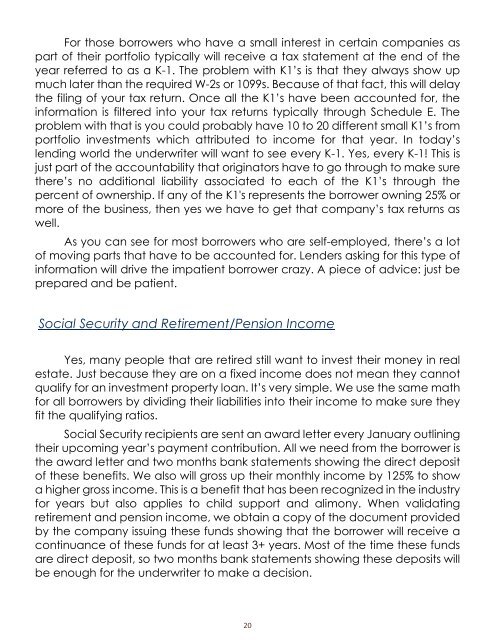You also want an ePaper? Increase the reach of your titles
YUMPU automatically turns print PDFs into web optimized ePapers that Google loves.
For those borrowers who have a small interest in certain companies as<br />
part of their portfolio typically will receive a tax statement at the end of the<br />
year referred to as a K-1. The problem with K1’s is that they always show up<br />
much later than the required W-2s or 1099s. Because of that fact, this will delay<br />
the filing of your tax return. Once all the K1’s have been accounted for, the<br />
information is filtered into your tax returns typically through Schedule E. The<br />
problem with that is you could probably have 10 to 20 different small K1’s from<br />
portfolio investments which attributed to income for that year. In today’s<br />
lending world the underwriter will want to see every K-1. Yes, every K-1! This is<br />
just part of the accountability that originators have to go through to make sure<br />
there’s no additional liability associated to each of the K1’s through the<br />
percent of ownership. If any of the K1's represents the borrower owning 25% or<br />
more of the business, then yes we have to get that company’s tax returns as<br />
well.<br />
As you can see for most borrowers who are self-employed, there’s a lot<br />
of moving parts that have to be accounted for. Lenders asking for this type of<br />
information will drive the impatient borrower crazy. A piece of advice: just be<br />
prepared and be patient.<br />
Social Security and Retirement/Pension Income<br />
Yes, many people that are retired still want to invest their money in real<br />
estate. Just because they are on a fixed income does not mean they cannot<br />
qualify for an investment property loan. It’s very simple. We use the same math<br />
for all borrowers <strong>by</strong> dividing their liabilities into their income to make sure they<br />
fit the qualifying ratios.<br />
Social Security recipients are sent an award letter every January outlining<br />
their upcoming year’s payment contribution. All we need from the borrower is<br />
the award letter and two months bank statements showing the direct deposit<br />
of these benefits. We also will gross up their monthly income <strong>by</strong> 125% to show<br />
a higher gross income. This is a benefit that has been recognized in the industry<br />
for years but also applies to child support and alimony. When validating<br />
retirement and pension income, we obtain a copy of the document provided<br />
<strong>by</strong> the company issuing these funds showing that the borrower will receive a<br />
continuance of these funds for at least 3+ years. Most of the time these funds<br />
are direct deposit, so two months bank statements showing these deposits will<br />
be enough for the underwriter to make a decision.<br />
20


